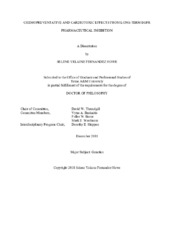| dc.description.abstract | The epidermal growth factor receptor (EGFR) is a gene expressed in epithelial cells and
is involved in a variety of diseases, including preeclampsia, intrauterine growth restriction,
embryonic lethality, diabetes, cardiac dysfunction, poxvirus propagation, and tumorigenesis.
EGFR is a member of the ERBB family of receptor tyrosine kinases, consisting of EGFR/HER1,
ERBB2/HER2, ERBB3/HER3, and ERBB4/HER4, and is a central point in an extensive network
of growth-promoting intracellular signaling pathways, making it a prominent inducer of cellular
proliferation and survival. Since EGFR is often co-opted by cancer cells through up-regulation of
the receptor’s expression and/or activity, there are several EGFR-targeted anti-cancer therapies
used in the clinic and many more currently being explored in preclinical and clinical trials. Any
potential cardiotoxicity rates for such therapies are unknown. Here we demonstrate that a
subgroup in the population, those at risk of dilated cardiomyopathy, may experience severe
adverse effects to EGFR inhibitors. BALB/cJ male mice treated with the EGFR tyrosine kinase
inhibitor AG1478 had an exacerbated increase in left ventricular mass. Our findings support the
utility of using genetically diverse mouse models to identify at risk groups. We also demonstrate
genetic background-dependent differences in baseline cardiac structure and function, as well as
differences in cardiac aging across four mouse strains (A/J, BALB/cJ, C57BL/6J, and FVB/NJ).
We explored the utility of EGFR pharmacological inhibition in cancer prevention by exposing
mice to AG1478 for 16 months. This timeframe allowed the mice to develop a variety of
spontaneous neoplasia, with pulmonary adenomas being the most prominent neoplasm. Our
findings demonstrate that EGFR-targeted treatment was ineffective for chemoprevention in a
model of spontaneous somatic mutations in genetic backgrounds with familial risks of cancer.
Although our findings suggest that EGFR-targeted treatment is not beneficial for
chemoprevention in the general population, high risk individuals with specific mutations or preexisting
lesions have not been excluded as groups that could potentially benefit from such
treatment. | en |


